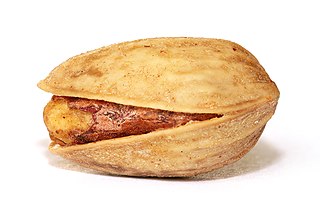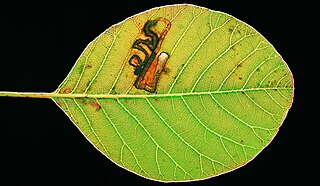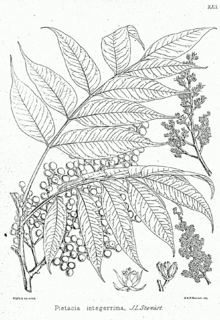
The pistachio, a member of the cashew family, is a small tree originating from Central Asia and the Middle East. The tree produces seeds that are widely consumed as food.

Pistacia is a genus of flowering plants in the cashew family, Anacardiaceae. It contains 10 to 20 species that are native to Africa and Eurasia from the Canary Islands, all of Africa, and southern Europe, warm and semidesert areas across Asia, and North America from Mexico to warm and semidesert United States, such as Texas or California.

Pistachio oil is a pressed oil, extracted from the fruit of Pistacia vera, the pistachio nut.

Telphusa is a genus of moths in the family Gelechiidae.
A pistachio is a culinary nut and the tree that bears it.

Pistacia atlantica is a species of pistachio tree known by the English common name Mt. Atlas mastic tree, Atlas pistachio, Atlantic pistacio, Atlantic terebinth, Cyprus turpentine tree, and Persian turpentine tree.

Simplimorpha promissa is a moth of the family Nepticulidae. It is widely distributed in southern Europe with the northern limit running approximately along the southern slopes of the Alps and along the Danube.
The Jylgyndy Forest Reserve is located in the Toktomat Zulpuev rural community, Nookat District, Osh Region, Kyrgyzstan. It was established in 1975 with a purpose of conservation of pistachio habitat. The forest reserve occupies 300 hectares.

Acalyptris pistaciae is a moth of the family Nepticulidae. It is found in the eastern Mediterranean region, where it is widespread in Greece, Cyprus and Turkey. It is probably also present in Syria and Lebanon. Mines collected in Israel in 1931 and identified as Simplimorpha promissa may also belong to be this species.

Pistacia integerrima is a species of pistachio tree native to Asia, commonly called zebrawood. It is often classified as Pistacia chinensis ssp. integerrima. It is used for a variety of purposes in India, including timber, dye, and fodder. The leaf galls are used in traditional herbalism for cough, asthma, fever, vomiting, and diarrhea.

Labidostomis longimana is a species of short-horned leaf beetles belonging to the family Chrysomelidae, subfamily Cryptocephalinae, tribe Clytrini.

Amyelois is a monotypic snout moth genus described by Hans Georg Amsel in 1956. Its single species, Amyelois transitella, the navel orangeworm, described by Francis Walker in 1863, is endemic to the tropical Western Hemisphere, including the southern United States. Its abundance in California increased greatly during the first half of the 20th century.
Altenia modesta is a moth of the family Gelechiidae. It is found in Bulgaria, Croatia, Greece, Albania, Armenia, Kyrgyzstan and Algeria.

Kurdish coffee or menengiç coffee, meaning pistachio coffee or terebinth coffee, is a traditional hot beverage in Kurdish and Turkish cuisine. It is made of ground roasted terebinth fruits as the main ingredient, and is caffeine-free. It is particularly popular in parts of southeastern Anatolia.
Istrianis femoralis is a moth of the family Gelechiidae. It is found on Sicily, Cyprus and in Italy, Slovenia, Croatia, North Macedonia, Greece, the Crimea and Turkey.
Telphusa microsperma is a moth of the family Gelechiidae. It is found in Kenya.
Telphusa phaulosema is a moth of the family Gelechiidae. It is found in Kenya.
Gelechia pistaciae is a moth of the family Gelechiidae. It was described by Filipjev in 1934. It is found in Asia Minor and the Middle East.

The Badghyz and Karabil semi-desert ecoregion covers the hills north of the central mountain ranges of Afghanistan, southeast Turkmenistan, and portions of Uzbekistan and Tajikistan. The landscape has been described as "savannah-like" and reminiscent of Africa, with desert sedges (Carex) and stands of wild pistachio trees. The area supports high biodiversity and a number of rare and endemic species, such as the endangered Turkmenian kulan (Equus hemionus kulan).











